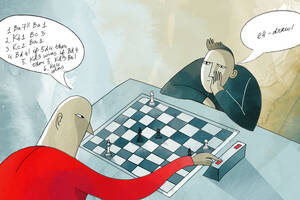The Internet has enabled explosive growth of online auction sites, job listing sites, and other “two-sided markets” in which the value of one side depends on the activity of the other side. The companies running these sites commonly assess customer value simply by tallying the total commissions and fees paid. But considering the interactions between buyers and sellers is necessary to understanding the true value of each customer, says Song Yao, an assistant professor of marketing at the Kellogg School of Management. Along with Carl F. Mela of Duke University, he has shown how companies—and individuals—can maximize their revenue from online auctions.
Personal experience inspired Yao to begin this research. When he was a student, he sold old textbooks and electronics using a popular online auction site. “At first I just listed the item and waited for someone to come along and buy it,” he recalls. “Over time, I realized that there were a lot of other sellers offering the same item.” This led him to think about finding the right time to post his listing. He started considering such factors as how crowded the market was for his item and how many bidders were available at any given time.
“From that point, I started to realize that my behavior would have an impact on the actions of other sellers as well as on the bidders.” As he examined the existing economics literature, however, he discovered that most of it focused only on the buyer or the seller, treating them independently. “I thought it would be interesting to look at the interactions of participants from both sides,” he says.
Digging into the Fees
Yao and Mela examined five months of data provided by a major online auction platform related to auctions of Celtic coins. The platform charged two types of fees to each seller: a listing fee and a commission. The researchers studied how a change in fees charged by the online platform affected seller behavior and how changes in seller behavior affected buyer behavior. The bottom-line assessment was the revenue generated for the auction platform.
Although the buyer does not pay the auction platform directly, the buyer adds some value to the auction platform, Yao notes. That is because, if the buyer did not exist, there would be no one to bid on the seller’s product and the seller would pay no commission. “If we ignore the interaction between the buyer and the seller and the other buyers who are competing against each other and driving up the price, we will have a biased outcome,” Yao says. For example, sellers must consider the number of likely bids and the probable number of competitive items in deciding when and where to list their items. Conversely, potential buyers often think about the number of auctions across which they can bid.
The model showed that an increase in listing fees would increase auction house revenues, while an increase in commissions would decrease them. The researchers theorize that this result flows from the fact that fees are a uniform pricing policy and commissions are a form of “high-value pricing discrimination.” It follows, Yao explains, that a decrease in commissions has a large effect on the profitability—for both the seller and the site—of more expensive items and items listed by sellers with good reputations. The increase in seller profitability for these listing leads to a large increase in listings for such items. For the Celtic coin category, Yao and Mela calculated that auction houses could increase their revenues by 3.9 percent by offering commission reductions to high-value sellers.
The researchers also used their model to examine the effects of a targeted pricing strategy in which high-value sellers faced lower commissions and higher per-item fees than low-value sellers did. They found that this customized pricing strategy could increase revenue for the online platform by 35 percent over a uniform pricing strategy.
Hidden Influences
Some of the less obvious ways in which the interactions of buyers and sellers influence auction platform profits can be examined using this model. For example, if a seller leaves the site, there will be increased competition between bidders for the remaining items. Prices will be driven up, resulting in higher per-auction commissions for the auction house. In turn, the higher prices paid by buyers and lower competition will encourage the remaining sellers to list some additional items. This is one of the most important insights from the model: To determine customer value in a two-sided market, companies need to account for the indirect effects that arise from interactions between buyers and sellers.
“In the past, I thought of the bidder as independent, static. They just randomly dropped by a Web site to make purchases. As a result of this research, I’ve learned that bidders are forward-looking entities.” — Yao
The authors illustrate this point using an example in which the largest seller at an auction platform paid $127 in fees and the largest buyer generated $26 in direct revenue. If the largest seller were to leave the site, the indirect effect would be a loss of $30 to the site, meaning that competitive effects would offset 24 percent of the total fees lost. (See Table 1.) If the largest buyer were to leave, bids from other buyers would offset 81 percent of lost revenue. Stated differently, valuing the participants without regard to competitive interactions overstates the value of the seller by one-third ($127/$97) and the value of the buyer by more than 400 percent ($26/$5).

Table 1. The effect of largest buyers and largest sellers on an auction site’s revenue.
Yao has applied what he learned from this research to his own online auctions. “In the past, I thought of the bidder as independent, static. They just randomly dropped by a Web site to make purchases. As a result of this research, I’ve learned that bidders are forward-looking entities,” he says. When buyers come to an auction site, they do not start bidding right away. Rather, they gather information about factors such as how many sellers are there and how many potential bidders are there who may compete with them and drive up the price. They also assess the possibility that the same item will be offered again in the near future if they do not have an immediate need for it.
Many buyers are willing to wait patiently for the right time to bid, Yao has learned. Quite often there is a high volume of bidders at lunch time, after work, and on the weekend. His advice to sellers? “If you really want to get the best price, you need to choose to list items so that the closing time is around those times.”
Further reading
Going, Going, Wrong: Competition and collusion among auction bidders
Place Your Bids: Strategies for selling and buying in auctions
Yao, Song, and Carl F. Mela. 2008. Online auction demand. Marketing Science. 27: 861–885.


